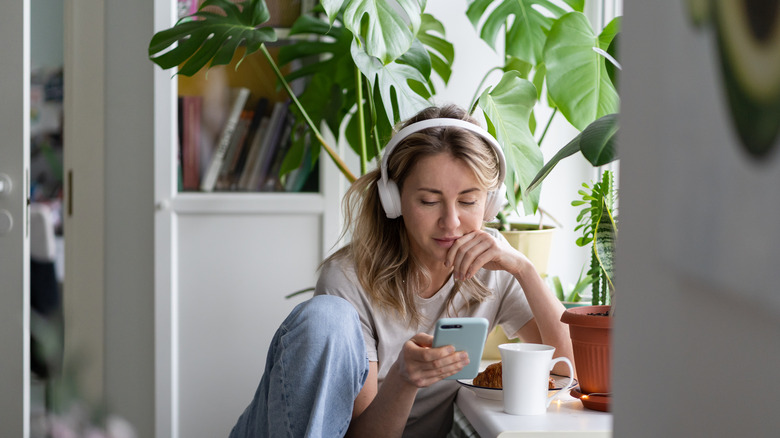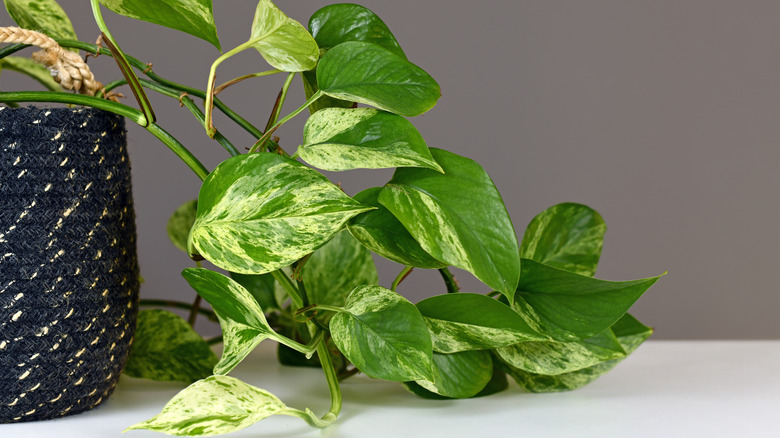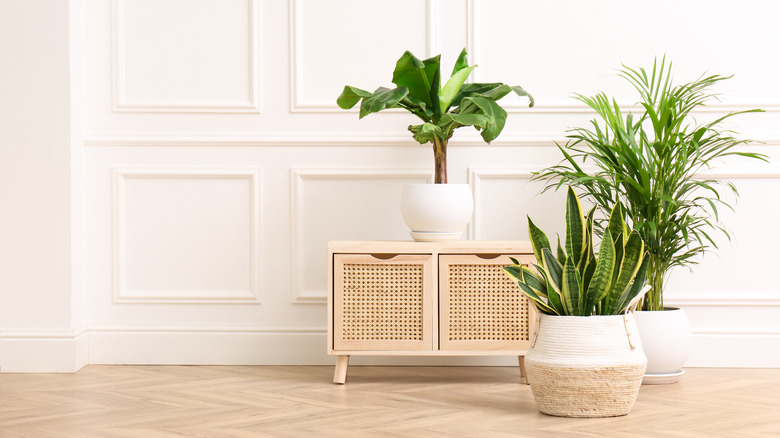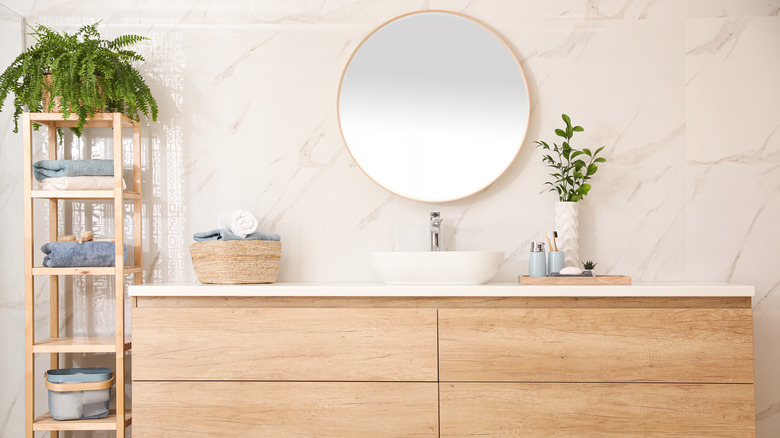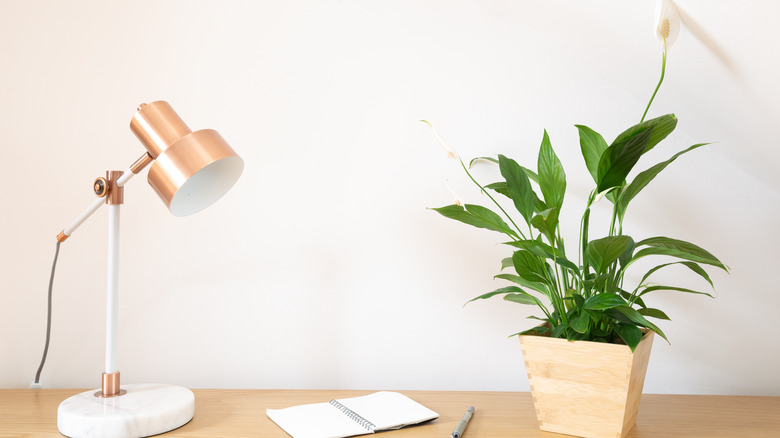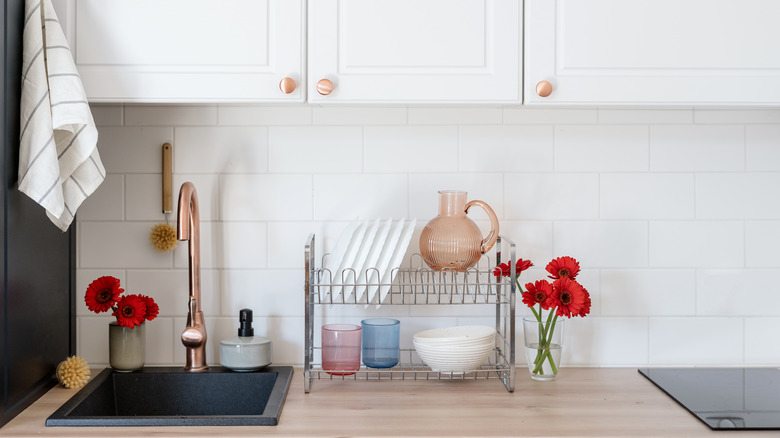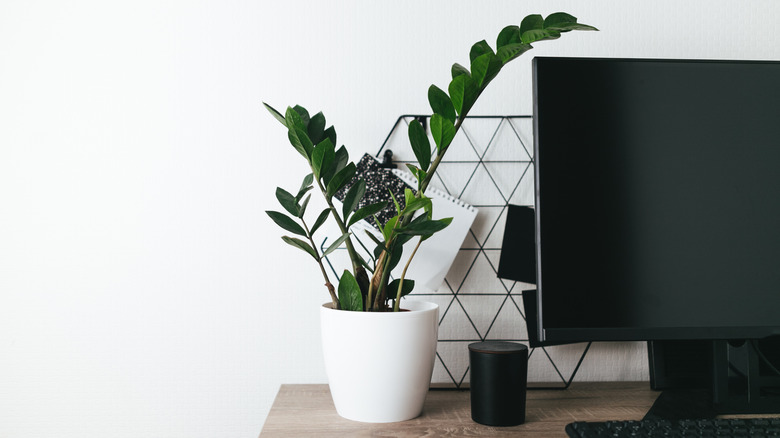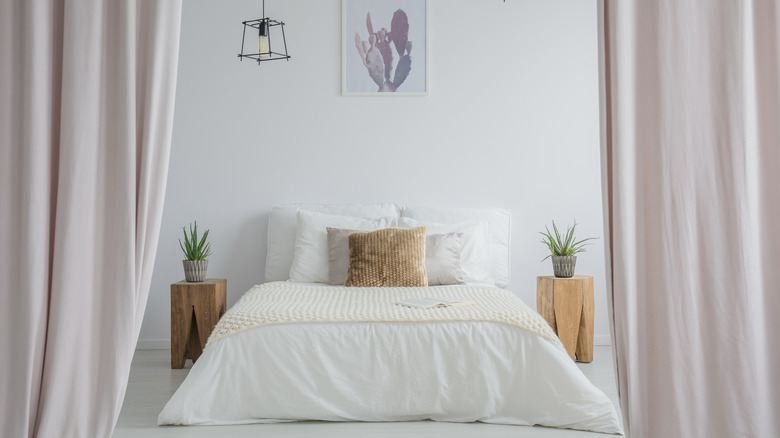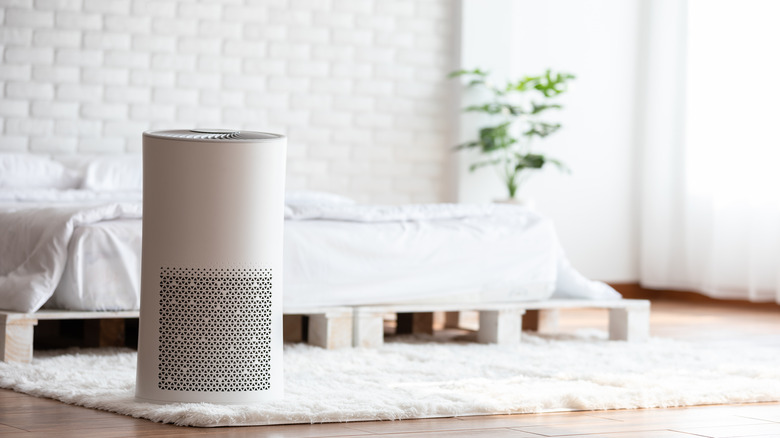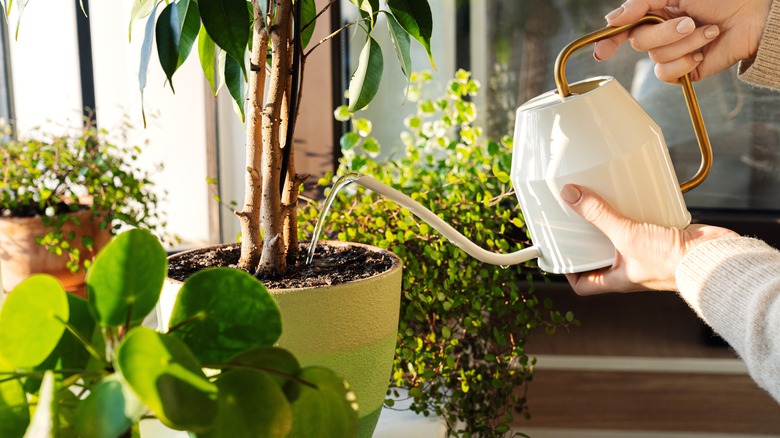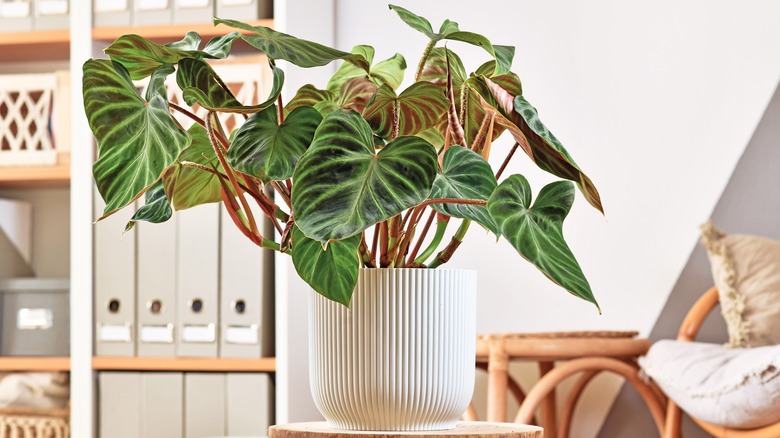The Best Plants To Help Purify The Air In Your Home
The power of plants is undisputable — they are the lungs of the earth. Indoor houseplants are a cornerstone of biophilic design because of their many positive effects on health. NASA's 1989 study on indoor houseplants that pull VOCs out of the air sparked this popular way of thinking, and for the past three decades, health-minded home gardeners have been filling their homes with leafy perennials while scientists have continued to study this relationship, with varied results. Just how effective plants can be at purifying the air in each and every home environment is debatable because it's dependent on a wide range of factors, making it difficult to measure. You could even say we're just beginning to understand how well plants clean the air.
However, several things are for sure. Per the International Well Building Institute, VOCs (benzene, formaldehyde, acetone, toluene, trichloroethylene, and others) exist more in today's homes thanks to building materials and cleaning supplies. VOCs are harmful to our health (they can be five times more concentrated indoors than outdoors, per the EPA), and plants, via photosynthesis, are known to absorb toxins and release better-quality air in return. Why not give it a shot? Here are the best types of plants that can help purify the air in your home.
Certain vines and trailing plants can purify the air
Golden pothos, philodendrons, and English ivy all have air-cleaning qualities. They can be displayed in hanging baskets or cascading over a shelf, a favored aesthetic in biophilic design. All three of these broad-leaf indoor plant species proved in the NASA study to absorb formaldehyde, which is found in flooring, fabrics, and household products. These plants can be poisonous to children and pets, which is all the more reason to put them up high on a shelf or hanging in a pot. For hanging plants, fill the bottom of a pot with rocks to create space for drainage water, advises Reader's Digest.
If you're unsure where to start, Time recommends that beginners start with golden pothos. It can pull benzene (found in plastics) and trichloroethylene from the air around it. Pothos is popular because it's hardy yet eye-catching, and can be trained as a climbing plant if desired. Like pothos, trailing philodendron is low-maintenance and can absorb toxins trichloroethylene, toluene, and xylene (via Plants Craze). English ivy is a more elegant-looking trailing plant but works just as hard. According to HealthDay, a study found that it reduced airborne mold by 78.5% in 12 hours. Hang it in a basket where you have low humidity and indirect light.
Floor plants, palms, and indoor trees to help detoxify your home
Consider scaling up your potted plant game with an indoor palm or tree. Whether tucked away in a corner (even one with low light) or placed in a thoroughfare, some palm and floor plant species do particularly well at filtering the air you breathe. In a 15-year study by Paharpur Business Centre in New Delhi that measured the success of plants in an office building, the Areca palm was the standout species for purifying the air. The study showed that its occupants experienced health improvements, including better breathing, fewer headaches, and increased blood oxygen. According to another study published in the Environmental Science and Pollution Research, Areca palm can reduce VOCs, carbon dioxide, and carbon monoxide by up to 95%.
Parlor palms and date palms have been shown to reduce a number of toxins, including formaldehyde. The broad-leaf lady palm also fights ammonia common in household cleaners and other VOCs, including formaldehyde and xylene.
Various types of popular dracaena species have topped lists in clean air studies. One with promising results, conducted in 2016 by researchers in New York and presented by the American Chemical Society, found the dracaena plant absorbed 94% of acetone in the air. Dracaena fragrans, or the corn plant, best filters nitrogen dioxide indoors. Additionally, weeping fig and rubber trees (one of the plant kingdom's highest oxygen producers) are floor plants that have been shown to aid in air filtration and removal of VOCs.
Ferns can help humidify and filter your air
Bathrooms can be just the right environment for harmful toxins to proliferate. They're places where cleaning and at-home salon products are used regularly, and outdoor ventilation can be lacking. Fortunately, ferns and bathrooms go together like peanut butter and jelly. Numerous species of ferns have been praised for their ability to filter chemicals out of the air while bringing humidity to their surroundings. They are ideal for bathrooms where there is humidity and just a bit of sunlight, and can be placed in the shower or hung in baskets.
A 2011 study by American Society for Horticultural Science showed that ferns — specifically the Japanese royal fern — removed formaldehyde better than 86 plant species studied. If you want to decorate with several ferns in your space, the Kimberly Queen fern successfully pulls up to 100% of formaldehyde from the air, and Boston ferns are one of the best plants you can get for cleaning air overall. Additionally, maidenhair ferns help with cigarette smoke, and rabbit foot ferns can take benzene and trichloroethylene from the air (via Plants People Places).
Breathe easier with peace lilies and flamingo lilies
Given how grand they look, peace lilies are surprisingly low-maintenance and hard-working against carcinogens and pollutants. Combine that with their proven propensity to regulate humidity and their positive symbolism (it's in their name), and these perennials make the ideal housewarming gift. Peace lilies were one of the clear frontrunners of the NASA test, which showed a reduction in airborne benzene, formaldehyde, ammonia, and all other VOCs they tested for. Peace lilies have also been shown to successfully reduce the amount of nitrogen dioxide in the air (via Air Quality, Atmosphere & Health). Peace lilies' flowers bloom in the spring; they can be happy indoors in various light and temperature situations, with slight humidity. They don't need water often, and when they do, they'll tell you by drooping. Don't worry — they'll bounce right back, says The Wall Street Journal.
Flamingo lilies look a lot like peace lilies, but they are actually different plants (neither are actually lilies). Like peace lilies, they thrive in an indoor climate with some humidity. These beautiful red-blooming houseplants have been shown to reduce levels of formaldehyde, ammonia, toluene, and xylene indoors (via Plantophiles). They're so gorgeous, you might forget how hard they're working.
Flowers that help get rid of VOCs
Wondering if pretty flowers in a vase or growing in a pot in your home can actually be heavy lifters when it comes to air purification? You're in luck. Certain blooming houseplants have more-than-meets-the-eye benefits. Gerbera daisies, bromeliads, mums (aka chrysanthemums), and azaleas are not only mood-lifters that can bring color to your interior; they're known as types of flowers that are particularly effective at reducing unwanted air pollutants.
Gerbera daisies were highly rated in the NASA study. They can increase oxygen and humidity in homes and absorb carbon dioxide. They have been found to reduce trichloroethylene, the carcinogen found in dry cleaning and paint products. They have a two-week lifespan as cut flowers, per Eastern Floral.
Bromeliads, low-light plants with red and orange blooms, will also increase oxygen and absorb carbon dioxide, per ProFlowers. In the American Chemical Society study on VOC reduction by four types of houseplants, these little tropical powerhouses performed best overall. They have also been used to decrease airborne mercury levels. For more brightly-lit environments, mums are annuals that like the humidity of an average home and can absorb formaldehyde, benzene, and ammonia, per Guide to Houseplants.
Good clean-air plants for low sunlight work situations
The good news is that you can perk up a dim corner in your office or cubicle with a desk plant that can also be put to work (pun intended) cleaning your office air. Office environments can feel far removed from nature, fresh air, and natural sunlight, and employees may leave plants unattended for days or weeks without watering them. Fortunately, some plants can handle it. In fact, the plants studied by NASA in 1989 were primarily low-light plants because the research aimed to assess plants' ability to improve life in a space station. These included Chinese evergreen, English ivy, snake plants, spider plants, golden pothos, philodendrons, and peace lilies, all of which showed the ability to filter toxic VOC pollutants from the air around them.
In a study published in Air Quality, Atmosphere & Health that mimicked an office environment, the ZZ plant proved to filter nitrogen dioxide (road traffic pollution that seeps into buildings) nearly as well as powerhouse purifiers like the corn plant and peace lily. The Wall Street Journal recommends ZZ plants for offices because they are proven air purifiers that only need water every two to three weeks. If you're looking for a larger plant that can fill up an empty space, broad-leaf lady palm also does well in low-light situations.
Plants known to increase oxygen while you're sleeping
All plants pull carbon dioxide out of the air and release oxygen during photosynthesis. Some plants do it more efficiently than others, and some even release oxygen at night, making them ideal for your bedroom. The Paharpur Business Centre study called the workhorse snake plant a "bedroom plant" for this reason. The snake plant, which is a succulent, has been shown to remove formaldehyde, benzene, xylene, trichloroethylene, and toluene from the air, per Healthline. It is popular because it's easy to care for, doesn't need to be repotted often, and has a striking appearance. Aloe vera is another popular overnight oxygen producer, and also helps with the filtration of formaldehyde and benzene, as per NASA. It has been used as a medicinal plant in many cultures past and present, and doesn't need much water, making it low-maintenance.
Plants that increase humidity can also be a welcome addition to your bedroom if you deal with dry skin or respiratory issues. Try a peace lily if you want to up your oxygen levels at nighttime and purify your air while also increasing humidity.
Using houseplants with air purifiers
If it's ultra-clean air you're after, then you may have considered an air purifier. Combining an air purifier with a collection of houseplants could cover all your bases, and hopefully even help your plants thrive. Air purifiers can remove dust, smoke, cooking smells, pollen, and pet dander from your home's atmosphere that houseplants can't, according to Home Air Guides. On the other hand, air purifiers don't get everything, and can even raise ozone levels. Houseplants may be preferred by people who don't have pets, live in a home with fewer toxins to begin with, don't want a mechanical filtration system, are concerned about energy usage, or are looking for a more affordable and easy-to-integrate option. Reasons to combine the two could be if you're worried about mold growing in your plants, you have allergies, or you want to take a deep breath knowing you're doing everything you possibly can for purified air. Bonus: According to Ionizerhub, air purifiers that use HEPA or activated carbon filters can actually help plants grow faster by removing pollutants that would otherwise impede photosynthesis. Keep in mind that air purifiers that generate ozone are harmful to plants.
If the weather allows, consider turning off your air purifier and simply opening a window for fresh air. The EPA reminds us that even though we spend 90% of our time inside, our homes are more polluted inside than outside. Researcher Stanley Kays told Time that allowing airflow between the inside and outside of your home can cleanse air more efficiently than houseplants.
Have variety in your home's biosphere
To make the best effort at purifying your home's air using plants, use a range of houseplant species and have them in different rooms. Standard recommendations are two plants per 100 square feet in your home. That equals to 18 plants for an average size 1,800 sq. ft. home, according to Home Air Guides. According to the National Wildlife Federation, researchers suggested 60 plants would suffice for a small household, while others believe 12 times that amount would be needed. That said, a school in Portugal that hung just six plants from the ceiling reported cleaner air, as reported in the Journal of Toxicology and Environmental Health.
Variety is important. The American Chemical Society concluded that plants filter chemicals differently, thus the more species the better. In addition to variety, grouping your plants closely to one another (as they would be in nature) is beneficial too. However, placing houseplants so they're tightly touching isn't recommended because it can slow down their growth by causing them to compete for natural light, not to mention gaining crossover bugs (via Braid & Wood). All the more reason to hang plants in baskets.
Cautions about plants in your home
The potential for adverse effects of household plants can be why some argue that houseplants do more harm than good when creating a healthy environment. Overwatering can lead to unwanted mold, bacteria, bugs, and humidity, and in turn, allergies and asthma. (A precaution you can take to prevent mold is to add moss or gravel to the top of your plant's soil, as per the National Wildlife Federation). Plants can even introduce pesticides into your home if they have been sprayed. In addition, certain plants' toxicity to pets and kids is a real concern. Thankfully, it's easy to look this info up before investing in a plant.
On the other hand, houseplants have some hidden benefits that you may not even be aware of, according to The Sill. This includes noise and stress reduction. For many people, the fact that just one potted plant on their nightstand can brighten their mood, and arguably help them take deeper, cleaner breaths when they wake up every day, is more than enough.
